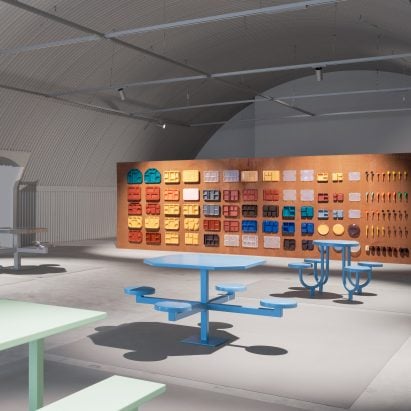Pastel-toned, suicide-proofed chairs are among the penitentiary furniture revealed to the public as part of Prison Times, the debut exhibition curated by the Dropcity centre for architecture and design in Milan.
The show, which opened in time for Milan design week, was born from a year-long research project investigating the role of design in the growing prison crisis.
“Tough on crime” policies have led to overcrowding and deteriorating living conditions in many countries – from Italy to the UK and the US – resulting in record numbers of inmates taking their own lives.
Dropcity is presenting prison furniture to the public in its Prison Times exhibition
To bring this overlooked issue to public scrutiny, Prison Times collates a selection of the everyday objects designed to structure life in custody, sourced directly from prison furniture contractors and presented completely unaltered.
“We wanted to understand: who are the designers that are part of this shadow system of furniture production?” said Giada Zuan, who led the investigation.
“It was complex to relate to these people, because it’s part of an industry, but it’s not really public,” she told Dezeen. “They don’t sign their names. There are no designers listed. They are just manufacturers.”
The furniture and sanitary ware were sourced from real suppliers
With very little public oversight, these companies produce products for a global incarcerated population that is nearing 11 million people, equivalent to an entire country with a population larger than Sweden.
Prison Times brings these mass-produced products into the limelight of one of Milan’s buzziest galleries, accompanied by a series of commissioned artworks that provide context through real-life footage, audio and data.
The exhibition’s name is based on the idea that prison furniture is carefully designed to control what inmates do at any given time, as objects are bolted on, weighed down or stripped back so they can be only used for their intended purpose.
Rows of stainless steel sinks and toilets feature in the Cleaning Time section
“Some of the manufacturers don’t even conceive these objects as design objects,” Zuan said. “They conceive them as products because they are part of an industry.”
“And part of what we want to do is make them understand that these objects have a design cause and consequence in relation to the body and the psychology of whoever is using them,” she added.
“Some of these objects are really kind of violent. They incorporate a lot of restrictive mechanisms.”
In line with this idea, the show is broken down into five sections – Sleeping Time, Cleaning Time, Monitoring Time, Eating Time and Entering Time – each occupying one of Dropcity’s converted railway tunnels behind Milan Central Station.
The first tunnel deals with Sleeping Time and explores the anatomy of the cell, as rows of floor-mounted metal cots are lined up next to plastic wardrobes with rounded tops that are impossible to climb.
Even mattresses are sealed using high-frequency welds to prevent tearing, and separated into three parts so they can’t be used to obscure the view through the cell’s peephole.
The toilets integrate sound insulation to discourage vandalism
An accompanying documentary film by architect Sofia Albrigo provides a glimpse into what life is like in these cells through found footage from inside Italy’s prisons.
The next section, dedicated to Cleaning Time, displays clinical stainless steel sinks and urinals alongside lidless toilets filled with sound-deadening insulation foam to discourage kicking or hitting the metal.
Nearby, a mixed-media installation by Altreconomia reporter Luca Rondi explores other ways prisoners’ bodies are controlled by visualising data on the use of psychotropic drugs – normally prescribed for serious mental illnesses like schizophrenia – to sedate inmates.
The Eating Time section features plastic meal trays and floor-mounted tables
The Monitoring Time section explores both the obvious video surveillance that inmates are subjected to and how furniture serves a similar purpose.
A selection of technical drawings breaks down the various ways these everyday objects were designed to control the behaviour of inmates.
With their de-escalating pastel colours and rounded corners, many of the furniture pieces almost look made for toddlers, especially in the Eating Time section with its monobloc plastic meal trays and chairs.
But in reality, the seats are produced by Pineapple Contracts – a UK manufacturer of so-called “anti-ligature” furniture, designed to prevent inmates from harming themselves or others by removing all elements that could be turned into ropes or cords.
High-security doors, walls and windows are displayed in their original colours
In the final tunnel, Entering Time chronicles the different types of high-security doors, walls and windows that are used not just to divide and contain but also to hide prisoners and their living conditions from public view.
“We wanted to bring visibility to this urgent matter and question the responsibility that architecture and design have in this situation,” Zuan said.
“We are really questioning: how can these objects help the current situation? Can they actually help? Or should we really revisit the existential purpose of prisons in general?”
The exhibition is on show until 31 May
Zuan and her team also created an accompanying book for the exhibition and curated a series of debates about the topic during Milan design week.
Previous editions of the festival have seen Dropcity host furniture and photography shows. But Prison Times marks the first exhibition entirely curated by the team at Milan’s new urban centre for design and architecture.
“This marks the beginning of what Dropcity wants to achieve, which is opening public debates on underreported issues,” Zuan explained.
Prison Times is on show at Dropcity from 3 April to 31 May. See Dezeen Events Guide for an up-to-date list of architecture and design events taking place around the world.
The post Dropcity exhibition exposes hidden violence of prison furniture appeared first on Dezeen.
